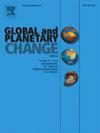A Late Glacial and Holocene sugar biomarker-based δ18O paleoclimate record from the Afro-alpine Central Lake, Bale Mountains, Ethiopia
IF 4
1区 地球科学
Q1 GEOGRAPHY, PHYSICAL
引用次数: 0
Abstract
The Eastern African region is an amalgamation of complex climate systems nestled in contrasting topographic barriers. Although rift basins are prime targets for studying the climate of the past, high-altitude climate archives in the context of paleoclimate research also offer invaluable insight and have yet to be fully explored. Here, we present a 17 kyr hydroclimate history of the Afro-alpine (4121 m a.s.l) Central Lake using a δ18O record established by analyzing hemicellulose-derived sugar biomarkers. The sugar biomarker patterns with a dominance of fucose indicate the predominance of autochthonous sedimentary organic matter. Therefore, the oxygen isotopic variability of the sugar biomarkers in general and of fucose in particular (δ18Ofucose) reflects δ18Olake water being controlled by climatic conditions, particularly lake water 18O enrichment by evaporation. Our δ18Ofucose record from Central Lake indicates strong enrichment during the Late Glacial. Around 15 cal kyr BP, the onset of more humid climate marks the beginning of the African Humid Period (AHP) in the Bale Mountains. The AHP was interrupted by an arid period during the Late Glacial – Holocene transition roughly coinciding with the Younger Dryas (YD). After the YD, humid climatic conditions prevailed again until the Late Holocene when a gradual shift towards drier climate started. Our δ18Ofucose record and interpretation agree well with the findings from adjacent low-altitude archives of Eastern Africa, the Indian Ocean paleoclimate records and the Asian Monsoon Domain, which suggests region-wide hydro-climatic teleconnections.
埃塞俄比亚贝尔山脉非洲高山中央湖晚冰期和全新世糖生物标志物的δ18O古气候记录
东非地区是一个复杂气候系统的混合体,坐落在对比鲜明的地形障碍中。虽然裂谷盆地是研究过去气候的主要目标,但古气候研究背景下的高海拔气候档案也提供了宝贵的见解,但尚未得到充分的探索。本文利用半纤维素糖生物标志物建立的δ18O记录,研究了非洲高寒(4121 m a.s.l)中央湖17 kyr的水文气候历史。以聚焦为主的糖生物标志物模式表明原生沉积有机质为主。因此,糖生物标记物的氧同位素变化反映了δ18Olake水体受气候条件控制,特别是湖泊水体蒸发富集18O。中央湖的δ18O聚焦记录表明,晚冰期具有强烈的富集作用。大约15 calkyr BP,更加湿润的气候的开始标志着贝尔山脉非洲湿润期(AHP)的开始。在晚冰期-全新世过渡期间,AHP被一个干旱期所中断,与新仙女木期(YD)大致吻合。YD之后,湿润的气候条件再次盛行,直到晚全新世,气候逐渐转向干燥。我们的δ18O焦点记录和解释与邻近的东非低空档案、印度洋古气候记录和亚洲季风域的发现一致,表明存在区域性的水文气候遥相关。
本文章由计算机程序翻译,如有差异,请以英文原文为准。
求助全文
约1分钟内获得全文
求助全文
来源期刊

Global and Planetary Change
地学天文-地球科学综合
CiteScore
7.40
自引率
10.30%
发文量
226
审稿时长
63 days
期刊介绍:
The objective of the journal Global and Planetary Change is to provide a multi-disciplinary overview of the processes taking place in the Earth System and involved in planetary change over time. The journal focuses on records of the past and current state of the earth system, and future scenarios , and their link to global environmental change. Regional or process-oriented studies are welcome if they discuss global implications. Topics include, but are not limited to, changes in the dynamics and composition of the atmosphere, oceans and cryosphere, as well as climate change, sea level variation, observations/modelling of Earth processes from deep to (near-)surface and their coupling, global ecology, biogeography and the resilience/thresholds in ecosystems.
Key criteria for the consideration of manuscripts are (a) the relevance for the global scientific community and/or (b) the wider implications for global scale problems, preferably combined with (c) having a significance beyond a single discipline. A clear focus on key processes associated with planetary scale change is strongly encouraged.
Manuscripts can be submitted as either research contributions or as a review article. Every effort should be made towards the presentation of research outcomes in an understandable way for a broad readership.
 求助内容:
求助内容: 应助结果提醒方式:
应助结果提醒方式:


